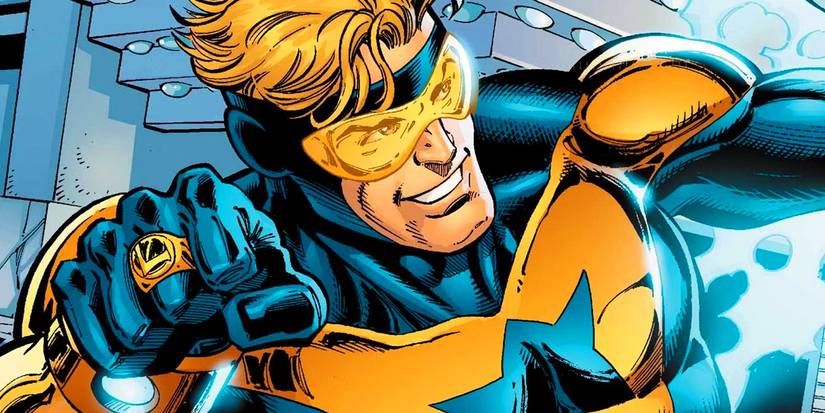Dr. Roy Meals, a longtime hand surgeon, likes to move his feet. He has climbed mountains and he has run three marathons.
But when he shared his latest scheme with his wife a couple of years ago, she had a quick take.
“You’re nuts,” she said.
Maybe so. He was closing in on 80, and his plan was to grab his trekking poles and take a solo hike along the 342-mile perimeter of Los Angeles. His wife found the idea less insane, somewhat, after Meals agreed to hook up with hiking companions here and there.
Dr. Roy Meals with his book, “Walking the Line: Discoveries Along the Los Angeles City Limits.”
But you may be wondering the obvious:
Why would someone hike around a massive, car-choked, pedestrian-unfriendly metropolis of roughly 500 square miles?
Meals had his reasons. Curiosity and restlessness, for starters. Also, a belief that you can’t really get to know a city through a windshield, and a conviction that staying fit, physically and mentally, is the best way to stall the work of Father Time.
One more thing: Meals’ patients over the years have come from every corner of the city, and the Kansas City native considered it a personal shortcoming that he was unfamiliar with much of L.A. despite having called it home for half his life.
To plot his course, Meals unfolded an accordion style map for an overview, then went to navigatela.lacity.org to chart the precise outline of the city limits. The border frames an oddly shaped expanse that resembles a shredded kite, with San Pedro and Wilmington dangling from a string at the southern extremities.

Dr. Roy Meals takes a break from his walk to talk with Louis Lee, owner of JD Hobbies Store, along West 6th Street in downtown San Pedro.
Meals divided his trek into 10-mile segments, 34 in all, and set out to walk two segments each week for four months, traveling counterclockwise from the 5,075-foot summit of Mt. Lukens in the city’s northern reaches.
Day One began with a bang, in a manner of speaking.
Meals slipped on loose rocks near the summit of Mt. Lukens and tumbled, scuffing elbows and knees, and snapping the aluminum shaft of one of his walking sticks.
But Meals is not one to wave a white flag or call for a helicopter evacuation.
“Later, at home, I employed my orthopedic skills to repair the broken pole,” Meals writes in “Walking the Line: Discoveries Along the Los Angeles City Limits,” his just-published book about his travels.
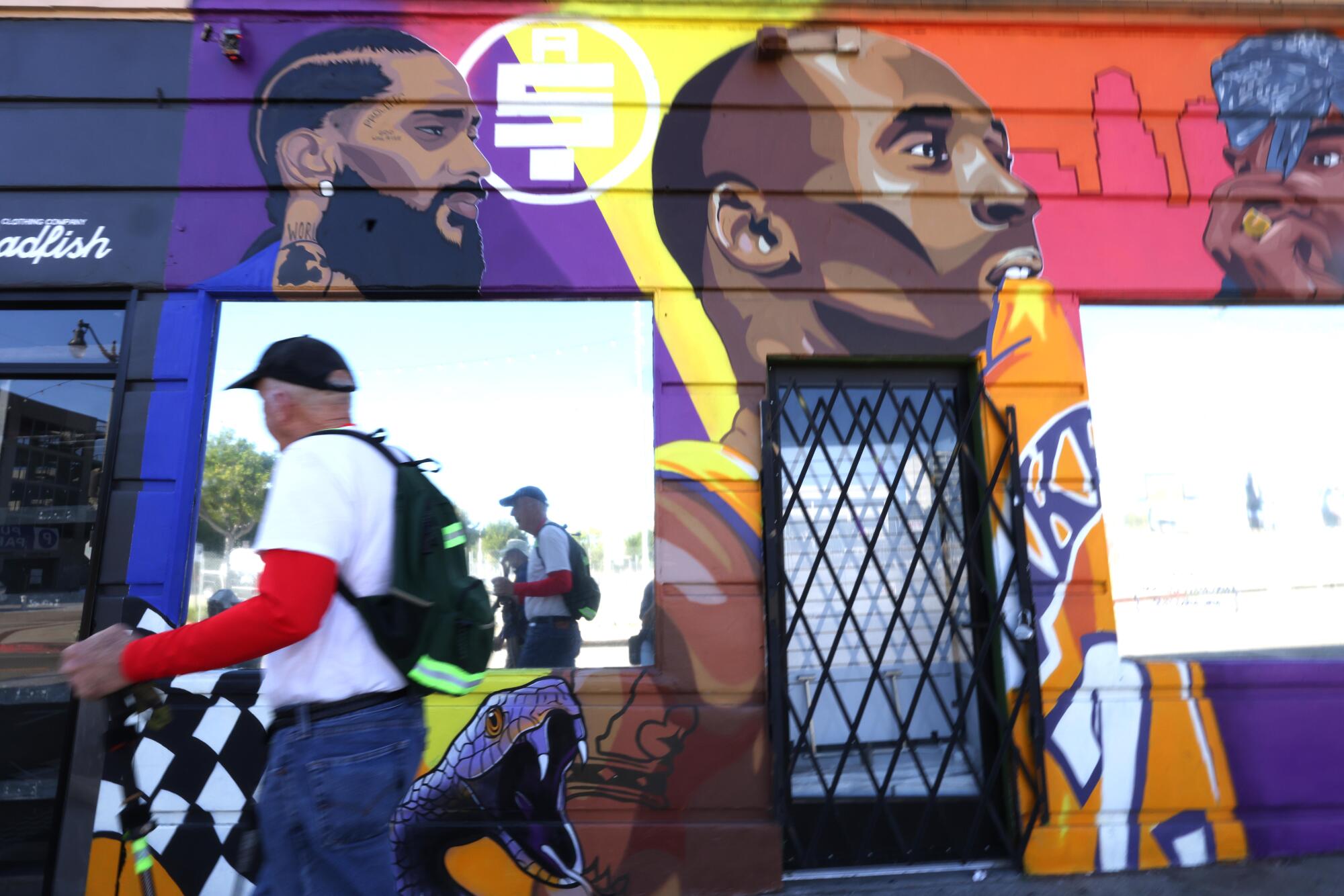
Dr. Roy Meals walks along West 6th Street in San Pedro.
Meals, now 80 and still seeing patients once weekly at a UCLA clinic, remained upright most of the rest of the way, adhering to his self-imposed rule of venturing no farther than one mile in from the city limits. To get back to his starting point each day, he often took buses and found that although it was slow going, riders often exited with a thanks to the driver, which struck him as “wonderful grace notes of acknowledgment.”
The doctor ambled about with the two trekking poles, a cross-country skier on a vast sea of pavement. He carried a small backpack, wore a “Los Angeles” ballcap and a shirt with the city limits outline on the front, and handed out business cards with a link to his book project.
Those who clicked on the link were advised to escape their own neighborhoods and follow Meals’ prescription for life: “Venture forth on foot, and make interesting, life-enriching discoveries. Wherever you live, be neighborly, curious, fit, and engaged!”
Meals was all those things, and as his surname suggests, he was never shy about sampling L.A.’s abundant offerings.
He tried skewered pig intestines at Big Mouth Pinoy in Wilmington, went for tongue and lips offerings at the Tacos y Birria taco truck in Boyle Heights, thoroughly enjoyed a cheeseburger and peach cobbler at Hawkins House of Burgers in Watts, and ventured into Ranch Side Cafe in Sylmar, curious about the sign advertising American, Mexican and Ethiopian food.
Meals tried hang-gliding at Dockweiler Beach, fencing on the Santa Monica border, rock climbing in Chatsworth, boxing and go-kart racing in Sylmar, weightlifting at Muscle Beach in Venice.
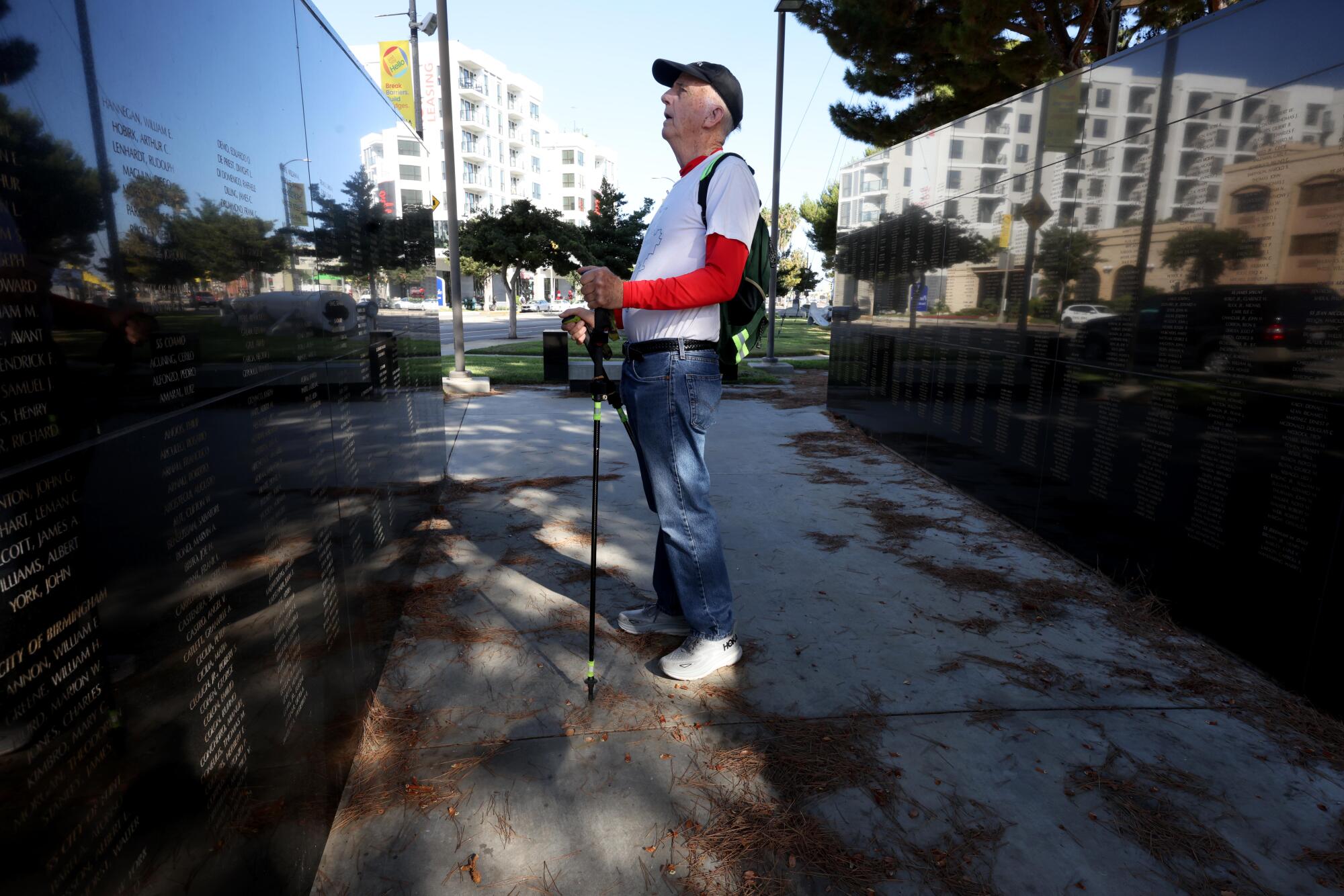
Dr. Roy Meals stops to take in the American Merchant Marine Veterans Memorial Wall of Honor while walking one of many paths he wrote about in his book.
In each sector, Meals sought out statues and plaques and explored points of history dating back to the Gabrielinos and Chumash, and to the days of Mexican and Spanish rule. He also examined the history of those peculiar twists and turns on the city perimeter, mucking through L.A.’s long-simmering stew of real estate grabs, water politics and annexation schemes.
What remains of the foundation of Campo de Cahuenga in Studio City was one of several locations that “stirred my emotions,” Meals writes in “Walking the Line.” There, in 1847, Andres Pico and John C. Frémont signed the treaty that ceded part of Mexico to the U.S., altering the shape of both countries.
In Venice, Meals was equally moved when he accidentally came upon an obelisk marking the spot where, in April 1942, more than a thousand Japanese Americans boarded buses for Manzanar.
“May this monument … remind us to be forever vigilant about defending our constitutional rights,” it read. “The powers of government must never again perpetrate an injustice against any group based solely on ethnicity, gender, sexual orientation, race or religion.”
At firehouse museums, Meals learned of times when “Black firefighters were met with extreme hostility in the mixed-race firehouses, including being forced to eat separately. … Little did I know that visiting fire museums would be a lesson in the history of racism in Los Angeles,” he writes.
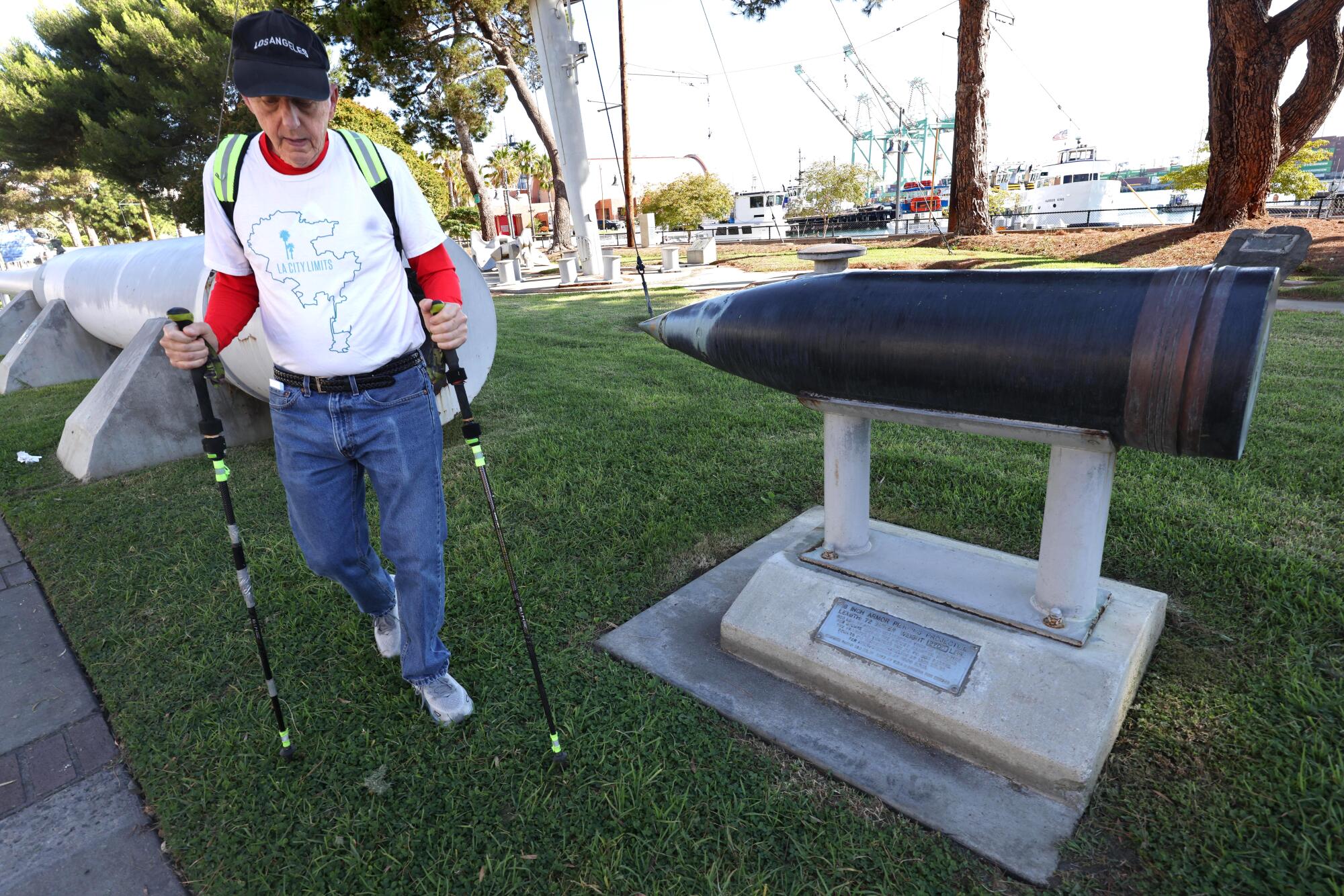
Dr. Roy Meals walks past a display of an armor-piercing projectile in San Pedro.
Although Meals visited well-known destinations such as the Watts Towers and Getty Villa, some of his most enjoyable experiences were what he called “by the way” discoveries that were not on his initial list of points of interest, such as the obelisk in Venice.
“Among those that I stumbled across,” Meals writes, “were the Platinum Prop House, Sims House of Poetry, and warehouses stuffed with spices, buttons, candy, Christmas decorations, or caskets. These proprietors, along with museum docents and those caring for disadvantaged children, bees, rescued guinea pigs, and injured marine mammals genuinely love what they do; and their level of commitment is inspiring and infectious.”
His book is infectious, too. In a city with miles of crumbling sidewalks and countless tent villages, among other obvious failings, we can all find a thousand things to complain about. But Meals put his stethoscope to the heartbeat of Los Angeles and found a thousand things to cheer.
When I asked the good doctor if he’d be willing to revisit part of his trek with me, he suggested we meet in the area to which he awarded his gold medal for its many points of interest — San Pedro and Wilmington. There, he had visited the Banning Mansion, the Drum Barracks, the Point Fermin Lighthouse, the Friendship Bell gifted to L.A. by Korea, the varied architecture of Vinegar Hill, the World War II bunker, the sunken city, the Maritime Museum, etc., etc., etc.
Meals was in his full get-up when we met at 6th and Gaffey in San Pedro. The trekking sticks, the T-shirt with the jigsaw map of L.A., the modest “Los Angeles” hat.
“Let’s go,” he said, and we headed toward the waterfront, but didn’t get far.

Dr. Roy Meals takes a break from his walk to visit with famed San Pedro resident John Papadakis, 75, former owner of the now-closed Greek Taverna in the neighborhood.
A gentleman was exiting an office and we traded rounds of “good morning.” He identified himself as John Papadakis, owner of the now-closed Greek Taverna restaurant, a longtime local institution. He invited us back into his office, a museum of photos, Greek statues and sports memorabilia (he and son Petros, the popular radio talk show host, were gridiron grinders at USC).
San Pedro “is the city’s seaside soul,” Papadakis proclaimed.
And we were on our way, eyes wide open to the wonders of a limitless city that reveals more of itself each time you turn a corner, say hello, and hear the first line of a never-ending story.
Down the street, we peeked in on renovations at the art deco Warner Grand Theater, which is approaching its 100th birthday. We checked out vintage copies of Life magazine at Louis Lee’s JD Hobbies, talked to Adrian Garcia about the “specializing in senior dogs” aspect of his “Dog Groomer” shop, and got the lowdown on 50 private schools whose uniforms come from Norman’s Clothing, circa 1937.
At the post office, we checked out the 1938 Fletcher Martin mural of mail delivery. Back outside, with a view of the port and the sunlit open sea, we met a merchant seaman, relaxing on a bench, who told us his son worked for the New York Times. I later found a moving story by that reporter on his long search for the man we’d just met.
“Traveling on foot allowed me to reflect on and grow to respect LA as never before,” Meals wrote in his book.
On our walk, while discussing what next, Meals said he’s thinking of exploring San Francisco in the same manner.
We were approaching Point Fermin, where Meals pointed out the serene magnificence of a Moreton Bay fig tree that threw an acre of shade and cooled a refreshing salt-air breeze.
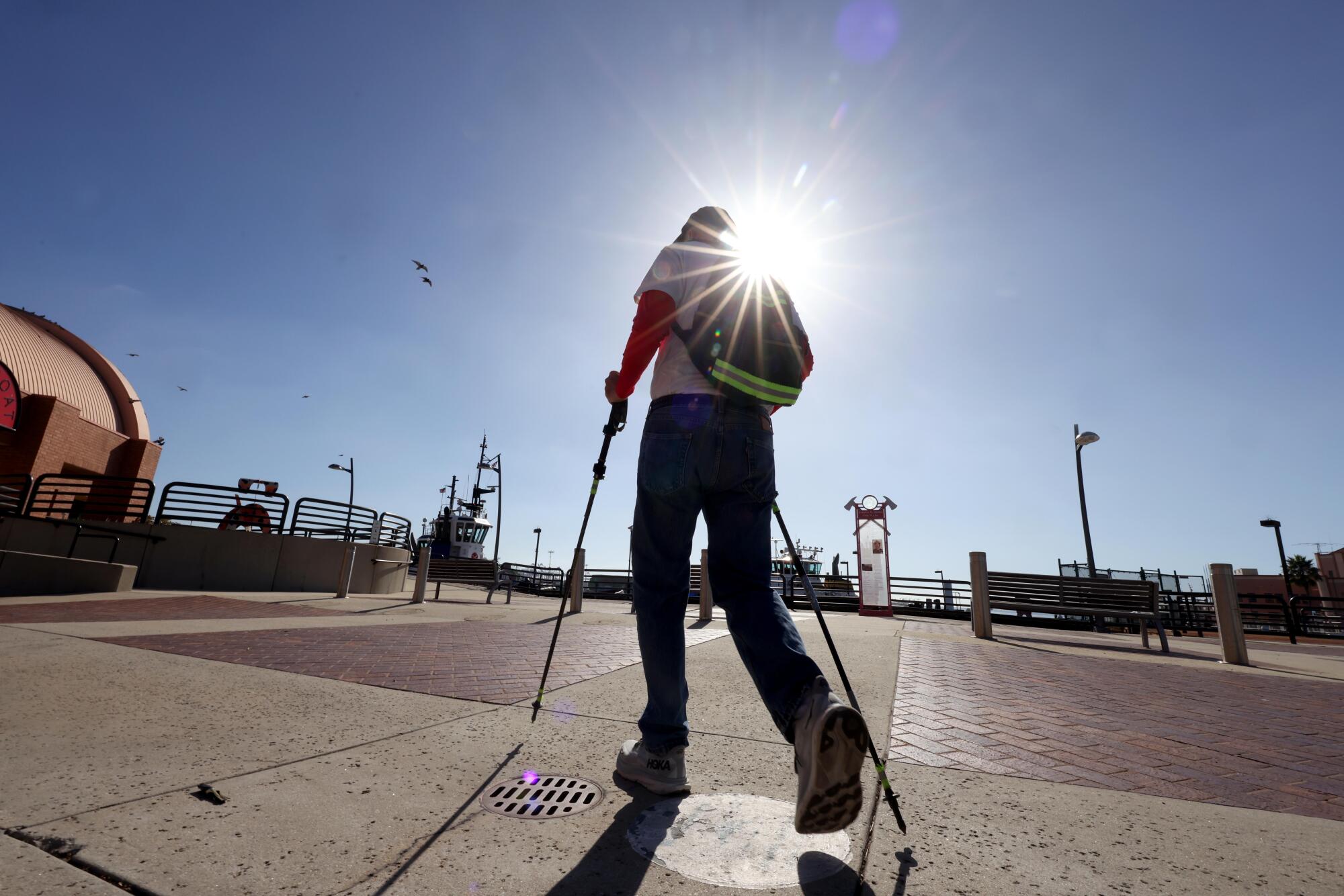
Dr. Roy Meals walks along the L.A. Harbor West Path, one of many paths he wrote about in his book, in San Pedro.
“If anything,” Meals told me, “I’m quicker to look at small things. You know, stop and appreciate a flower, or even just an interesting pattern of shadows on the street.”
The message of his book, he said, is a simple one.
“Basically, just slow down and look.”
steve.lopez@latimes.com
This story originally appeared on LA Times







